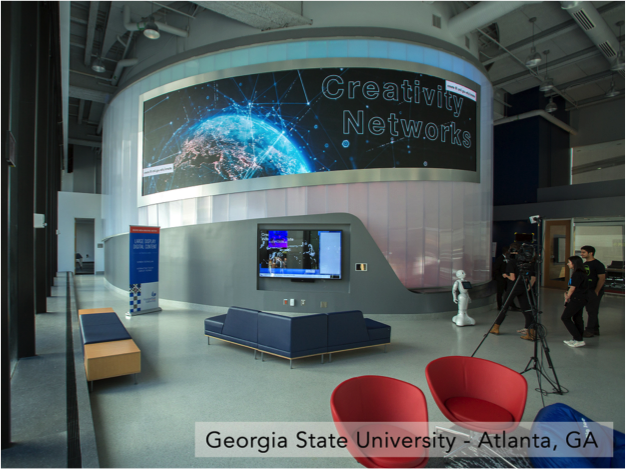NanoLumens Display Becomes the Centerpiece of Creativity at Georgia State University’s Creative Media Industries Institute
 ATLANTA, GEORGIA, December 5, 2017 — When Georgia State University set out to design a new home for its Creative Media Industries Institute (CMII), it decided to make a statement about its mission that would be seen and immediately understood by the thousands of people who would pass by the new building, which is located on the Woodruff Park in downtown Atlanta, Georgia. The state-of-the-art, ultra-modern home to the university’s digital media and film industries studies had to become immediately iconic, according to Elizabeth Strickler, CMII Director of Media Entrepreneurship and Innovation, and it had to visually communicate digital innovation.
ATLANTA, GEORGIA, December 5, 2017 — When Georgia State University set out to design a new home for its Creative Media Industries Institute (CMII), it decided to make a statement about its mission that would be seen and immediately understood by the thousands of people who would pass by the new building, which is located on the Woodruff Park in downtown Atlanta, Georgia. The state-of-the-art, ultra-modern home to the university’s digital media and film industries studies had to become immediately iconic, according to Elizabeth Strickler, CMII Director of Media Entrepreneurship and Innovation, and it had to visually communicate digital innovation.
To achieve this iconic stature, the university turned to NanoLumens, award-winning creators of compelling interactive LED visualization solutions, for a solution that could not be found on any other university campus in the country — a solution that would transcend being a display and become a canvas for the creative expression of the students studying at the institute.
“Our new Creative Media Industries Institute building is now, quite literally, a beacon of creativity that enables our students to experiment and prepare for careers in the rapidly changing fields of media and technology,” Strickler said. “It’s really important to differentiate our program, to show our interactive capability and technological prowess. When we moved forward with the design of a new building, we knew we had an opportunity to provide our students and the larger community that traverses Woodruff Park every day with something novel and exciting. Building on the success of our original “Window Project” at the old building, in which we exhibited artists’ digital creations in large format by projecting them onto frosted windows, we wanted to create a larger installation space that featured technology that was better, brighter and more advanced than projection technology.”
The search for this new technology led her to NanoLumens, another Atlanta-area design visionary. “As soon as I visited the NanoLumens showroom and met with their team, I knew that we shared the same vision for the project and for the larger goal of making Atlanta a hot bed for media and technology,” she explained.
Strickler also met with the architects at Cooper Kelly, and told them she wanted the centerpiece of the new building lobby to be a giant interactive media display, just like The Window Project, but more advanced. Strickler added, “One of the main problems was that projection is very hard to use in daylight situations – something that NanoLumens technology solved – and also that working with six projectors to display a single image was incredibly complicated. We knew a single massive display would be the answer.”
Throughout talks with the architects, the idea of utilizing a curved surface kept popping up, another area where NanoLumens’ technology is unrivaled. In the end, the decision was made to build a curved wall in the building’s main entrance, which has 20-foot ceilings and wall-to-wall windows, making it a highly visible location for thousands of daily passersby.
Not content to simply have a massive curved HD display, they also agreed that a standard 16:9 rectangle was uninspiring. Luckily there are no limits to the creativity and engineering capability of NanoLumens, and the final order became a 34” wide curved trapezoid, with the left and right ends standing 10’ and 7’ tall, respectively, resulting in a gentle sloping bottom for the display. Utilizing a 3mm pixel pitch, the display has a truly unique pixel count and display ratio that challenges students to step out of their comfort zone and create digital media projects specifically for this display.
To show off the new technology, the institute’s opening day featured an interactive installation from artist Pablo Gnecco and the 9to5.tv team that linked a web page to the display and allowed attendees to draw on the NanoLumens display using their mobile devices.
According to Strickler, one benefit of this is getting more students excited about careers in media. “We want to triple the workforce in the future of media production,” she explained. “Growing entrepreneurship within the media space is huge right now, with new programming and novel interactive experiences being introduced almost daily. As one of the nation’s leading media production education programs, we strive to give students the best tools to do research and development within the purview of media creation.”
To Arch Nelson, Southeast Sales Director at NanoLumens, the city presents great opportunities for graduates schooled in media creation. “Atlanta has a growing media industry,” he said, “with everything from gaming companies to film production booming, providing local opportunities for graduates who learn at the advanced laboratory at GSU. By working with what might be the first and only trapezoidal curved display in the world, students have the means to express themselves creatively by working with the technologies of the future.”
The display doesn’t simply sit on a blank wall, either. Instead, Cooper Kerry envisioned the curved wall to be comprised completely of LED lighting, so that the entire wall surrounding the display can also be programmed and integrated to project various colors and intensities along with the on-screen content.


